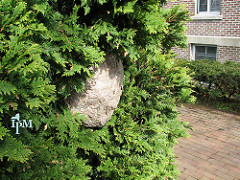Most of the wasps we’re too familiar with (and afraid of) are sociable with their own kind, building large nests in trees or underground. The problem is when they build nests under your eaves, picnic tables, or even (if you’re a farmer) under the seat of that baler you’re about to rev up as part of your pre-harvest maintenance check.
At a distance these wasps make great neighbors. As predators of flies, caterpillars and other soft-bodied insects, they help keep their numbers in balance. And that balance, that ounce of prevention, is a core tenet of IPM. But wasps are trigger-happy, so to speak — grab that picnic table to move it out of the sun and you’ll wish you looked underneath it first.
We could talk about any wasp you want, but today we’re focusing on bald-faced hornets. Just know that you can also apply IPM’s preventive tactics — we’ll get to that later — to your standard-issue yellow jackets, paper wasps, mud daubers and honey bees.

Bald-faced hornets house their colonies in large, enclosed carton nests. Like most wasps (and bees) these mostly mild-mannered critters turn nasty when their nest is threatened. They don’t know you had no intention of harm. But when bald-faced hornets live too close, yes, they represent a public health concern.

Did You Know…?
- What’s in a name?: White-faced hornets can be easily identified by the large patch of white on their faces.
- Family relations: This hornet is the largest yellow jacket species in North America.
- By the numbers: A nest can contain hundreds of hornets, and most will attack to protect their queen.
- Danger! White-faced hornets have unbarbed stingers, so they sting repeatedly. (Author’s note: Take it from me — disturb a nest and yes, you might get stung way more than you’d like.)
- Beneficial insect: White-faced hornets are important predators of flies, caterpillars and other soft-bodied insects.

Since technically it’s still spring and a chilly May slowed them down, you still have time. Inspect (in IPM lingo, “scout”) the aforementioned eaves, picnic tables, and outdoor equipment as well as the undersides of the railing on your porch or deck; that sort of thing. You’re looking for small carton nests that look like these, only way smaller. For other stinging wasps, keep and eye out for what looks like clots of mud (nifty inside, should you get a chance to dissect one) and the clusters of open cells, rather like honeycombs, that comprise a paper-wasp nest. Basically, you want to find a nest under construction, as it were — one with just a few workers ferrying back and forth to care for their queen.
Did You Know…?
- Last year’s empties: See a scary-big nest? Most likely it’s from last year — and wasps don’t reuse them. On the other hand, a subtle scent left behind tells other wasps that this could be a good place to build a nest of their own. So get rid of empties.
Moving quietly on a warm-enough day, stake out a claim nearby and watch the nest for 15 minutes or so. See any wasps? You’ve got an active one. No wasps? Best to scrape the old nest off so they won’t worry you later.
How to get rid of them? At dusk or dawn (dawn is better — it’s usually cooler) get out there with a tall pole, a SuperSoaker, or a hose with a good nozzle on it (you want a focused, powerful stream of water) and knock them down one at a time. Then stomp on them. Need a light? Don’t shine it right on the nest; better yet, cover your light with red cellophane. (Wasps don’t register red.)
Looking ahead — for larger nests later in summer, ask yourself if the nest is close enough to where you live, work or play to pose a significant threat. If it’s at a distance, best to leave it be.
More prevention (core IPM!): cover outdoor garbage receptacles and pick up dropped fruit under fruit-bearing trees. Integrated pest management can help to determine if a bald-face hornet nest is a danger and what to do if it should be removed.
For more information visit:
- How to Prevent the Buzz – Sting – Ouch! of Bald-Faced Hornets fact sheet
- Inspect for Wasps and Avoid the Sting blog post
- Wasp and Bee Management: A Common Sense Approach book
- Stinging Insect IPM video
For more information from the New York State IPM Program on other stinging insects, click here.